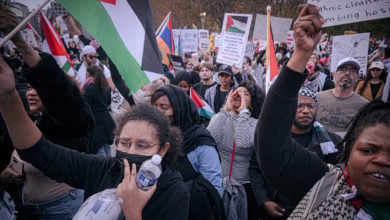With the outbreak of revolutionary movements in Tunisia
and Egypt, the Middle East has witnessed mass uprisings against U.S. client
dictators in many countries, including Yemen, Algeria and Jordan.
In concert with imperialist media outlets, many liberal
forces are drawing parallels between the mass uprisings in U.S. client Arab
states and the Green opposition movement in Iran. All demonstrations are lumped
into one big movement for “democracy,” with no attempt made to understand the
dissimilar, and in fact opposite, characters of these movements.
Even without the benefit of a class analysis, there is one
obvious difference between the revolutionary movement in Egypt and the Green
opposition in Iran. In Egypt, the movement encompasses millions of people from
different classes against the U.S. client Mubarak dictatorship. The
dictatorship has very little social base left. There were no pro-Mubarak
demonstrations, except for the few hundred hired thugs and policemen out of
uniform that tried unsuccessfully to quash the protests. In contrast, in Iran,
on many occasions, millions of predominantly working-class people have
demonstrated in support of the Islamic Republic.
Right after the June 12, 2009 elections, even during the
peak of large Green demonstrations, there were marches and rallies in support
of President Ahmadinejad and Ayatollah Khamenei, including the June 17 “unity”
rally in Tehran and the June 19 Friday Prayers at Tehran University, each
attended by hundreds of thousands. So, while in Egypt and Tunisia it is close
to the absolute majority of the people on one side and the state on the other,
in Iran there have been two groups of people demonstrating, one for and one
against the regime.
On Feb. 11, 2010, on the 31st anniversary of
the revolution, the pro-revolution turnout of millions dwarfed the peak turnout
of the opposition in June 2009. In addition to accounts of eyewitnesses and
reporters, helicopter shots showed a crowd stretching for several miles and
into Azadi (Freedom) Square. On Feb. 11 of this year, like all previous years,
people demonstrated in support of the revolution in cities across Iran. In
Tehran alone, despite rain and snow, hundreds of thousands of people converged
on Azadi Square where Ahmadinejad gave a rousing speech, drawing parallels
between the Iranian revolution of 1979 and the Egyptian revolution. Mubarak
fell 32 years to the day of the victory of the Iranian revolution. The fall of
the U.S. client Shah and that of the U.S. client Mubarak: that is an apt
comparison.
But the corporate media outlets have given scant coverage
to pro-government demonstrations in Iran while magnifying those of the opposition.
This has given rise to the liberal narrative that the “people of Iran” are
against the regime, ignoring the fact that Iranian society has been deeply
polarized, and that pro-government forces have demonstrated in numerically
superior numbers.
But more important than the number of demonstrators on
each side is the character of the opposing camps. The fictional “people are
demonstrating against the government in unison” narrative shies away from
having to do an inconvenient analysis.
Liberal forces have accused the Party for Socialism and
Liberation and other progressive forces that have identified the Greens as a
right-wing pro-imperialist movement, of being hypocritical for supporting
pro-democracy movements in some countries and not others. It escapes them that
every movement, every political development, should be analyzed in the context
of its specific conditions. Supporting every group of people that demonstrates
in the streets irrespective of its political character is not a democratic
principle.
The Tea Party and other right-wing forces have mobilized
scores of people on various occasions. Right-wingers brought tens of thousands
to Glenn Beck’s “Restoring Honor” rally in Washington, DC, on Aug. 28, 2010.
They held their rally at the exact site and on the anniversary of Martin Luther
King’s 1963 speech. And as they often do, right-wingers on that day tossed
around terms like liberty and democracy, and even demagogically used
anti-corporate language and expressed opposition to the bank bailouts. But not
one leftist or progressive characterized this reactionary rally and the forces
behind it as a democratic movement that should be supported. The “all
demonstrations are democratic” principle, apparently, applies only to oppressed
countries, particularly those targeted for regime change by imperialism.
There is nothing progressive about the Green opposition
movement in Iran, its vague calls for democracy notwithstanding. On domestic
policy, the official leaders of the Green movement, Mousavi and Karroubi, stand
for a streamlined process of privatization, reducing or ending subsidies to the
poor and for more market-oriented state management of the economy. The Green
movement’s rank and file is far to the right of its official leaders, including
people who favor the return of pre-revolutionary monarchy.
The Green Movement’s apparent support for the
revolutionary movement in Egypt is comical. Mousavi had openly stated his
opposition to President Ahmadinejad’s material and political support for Hamas
and Hezbollah, leaders of liberation movements in Palestine and Lebanon: “We
should not be more Palestinian than the Palestinians themselves.” The battle
cry of the Greens during the June 2009 demonstrations was “Not Gaza, Not
Lebanon, I give my life for Iran.” In subsequent months, this chant morphed
into “Not Gaza, Not Lebanon, sacrifice both for Iran.”
It is not uncommon for supporters of the Green Movement to
use racist anti-Arab language. Despite the strong national chauvinistic
attitude of this movement, in recent weeks, the Greens have gone
internationalist, insisting that they be granted permits to march in support of
the people of Egypt, and even claiming that they had inspired the Egyptian
movement!
Democracy is not an abstract concept above and beyond
class relations. The political system in the United States, for example, makes
it obvious that democracy is a form of governance that serves the interests of
the capitalist class. This is laid bare when the U.S. government literally
takes from the working class and gives to the banks. The key question to be
asked is: democracy for which class and against which? Modern day democracy is
a class phenomenon much as Greek democracy was democracy for the landlords and
nobility against the slaves and serfs.
Political forces that often find themselves on the side of
imperialism supporting “democratic” movements in Poland one day and Tiananmen
Square the next overlook the class character of democracy. This oversight,
however, is not so much an analytical error but an indication of the class
character of such forces.
The mass uprisings in Tunisia, Egypt and other Middle
Eastern countries are not democratic merely because the people are calling for
democracy and freedom. They are revolutionary because they are a movement
against U.S. client dictatorships that betray the interests of the masses in
favor of imperialist capital and their domestic clients. They are movements not
just for formal democracy but for independence and exercising a nation’s
sovereignty and control over its political system and its resources. These
truly democratic movements are not to be confused with movements that hide
behind the term democracy to promote pro-imperialist policies and against the
interests of the working people and the poor.
To group together countries like Iran and Syria with Egypt
and Tunisia is overlooking the obvious fact that the former are governed by
states that stand for their country’s independence, the latter by states
representing imperialist interests. This difference is not coincidental, of
secondary significance or a variation in form.
Imperialists and colonizers do not bring democracy to
oppressed peoples. They never have. For an oppressed people, nothing is less
democratic than having their country’s resources plundered by multinational
corporations, their political leaders handpicked by foreign governments, their
state’s major decisions dictated from abroad. No amount of formalistic
democratic institutions, where they exist, can compensate for the inherently undemocratic
relations between the oppressor and the oppressed.
Although there is a difficult road ahead, the heroic
struggle of the Egyptian masses promises future victories beyond the fall of
Mubarak, victories that will translate into material gains for the
working-class majority.






